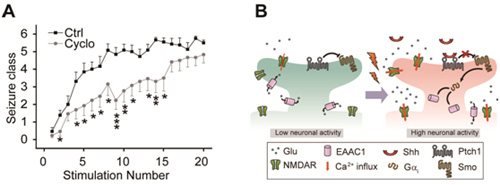Time:2016-04-12
Epilepsy is one of the most common chronic neurological disorders and affects 1% of population of the world. Glutamate is the principal excitatory neurotransmitter in the mammalian central nervous system. Failure in regulation of glutamate levels in the extracellular space canresult in excitatoxicity-related diseases,includingepilepsy. Increasing glutamate uptake is a rapid way to clear glutamate from the extracellular fluid, so it has an important rolein preventing the excitatoxicity.
In a recent study, researchers at the Institute of Neuroscience, Chinese Academy of Science, reported that sonic hedgehog (Shh) inhibits glutamate transporter activities in neurons to rapidly enhance extracellular glutamate levels and affect the development of epilepsy. Shh is quickly released in response to epileptic, but not physiological, stimulations. It inhibits neuronal glutamate transporters throughits downstream signaling molecules Smoothened and G?i. Inhibiting Shh signaling greatly reduces epileptiform activities in both cell cultures and brain slices. Moreover, pharmacological or genetic inhibition of Shh signaling markedly suppresses the development of epilepsy in kindling or pilocarpine models.
These results suggest that Shh contributes to the development of epilepsy and suppression of its signaling prevents thedevelopment of epilepsy. Thus, besidesplaying an important role in cell proliferation and differentiation during early development, Shh can also act as a modulator of neuronal activity to rapidly regulate glutamate levels during seizure.
The paper entitled “Sonic hedgehog is a regulator of extracellular glutamate levels and epilepsy” was published online in EMBO Reports on 4th April. Dr. FENG Shengjie, Dr. MA Shaorong and Dr. JIA Caixia from the Institute of Neuroscience, CAS were the first authors.
The work was supported by the grants form National Natural Science Foundation of China.

A. Effect of Shh pathway inhibitor cyclopamine (Cyclo) on the progression of seizure class in the mouse kindling model.
B. A working model: epileptic activity triggers sequential responses, including Shh release, inhibition of glutamate transporter activity, and increase in extracellular glutamate, leading to epilepsy development.
 附件下载:
附件下载: